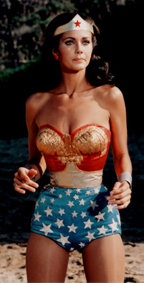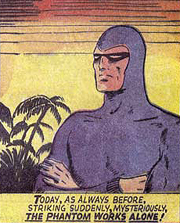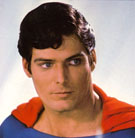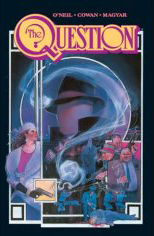Imagine me jumping up and down and pointing to myself and waving a book and yelling, Buy this you gotta buy this it’ll make you happy and rich and solve all your problems and give you Jessica Alba’s phone number it’s the greatest thing since similes…
Now imagine me reverently kissing the hem of George Bush’s garment.
One event is as likely to occur as the other.
I tell you this because soon I will mention a collection of stuff I wrote before some of you were born and I wouldn’t want anyone to think for a nanosecond that I was recommending you buy it. We Missourians who have attained a certain degree of maturity do not so demean ourselves. (We sip our tea and doze in the afternoon sun instead.)
With that caveat…
Yesterday a Santa’s helper from Brown dropped an early Christmas (or Halloween) present on the front stoop, a box of graphic novel-format volumes titled Zen and Violence. Now, somewhere on the space-time continuum between my typing these words and you reading them, they will be inspected by Mike Gold, who is the editor of this department and also edited the aforementioned collection of comic books. Let us pause to consider that maybe the space-time continuum is, indeed, curved, and then enter a timid demurral regarding that title, Zen and Violence.
Not mine. Not Mike’s, as far as I know. My first problem is this: there isn’t much Zen in those pages. A smidgen, maybe, but when I did the stories I may have thought I knew more about Zen than I did. I’m not sure how the series came to be identified with Eastern thought, but it did, and if it does for someone else what the works of Kerouac and Ginsberg did for me – point to the Something Else out there – then maybe I should shut up and smile and bow and retire.
My second problem: Yes, there is plenty of violence in the stories, or action, as some prefer to euphemize it. These were, after all, published as superhero comics in 1986-1987 and nobody back then was buying superhero comics to study philosophy, nor should they have been; violence…er – action was part of the package. Nor do I want to be snooty about it; violence has some valid dramatic uses (and I guess action does, too.) But I don’t want anyone to think I recommend violence as an all-purpose problem solver, and putting the word in a book title might give that impression.
Okay, okay, I’m being paranoid…
RECOMMENDED READING: You want to know something about Zen? Brad Warner’s your man. Warner is a musician, monster movie fan and Zen priest and that, my friends, is a resume a lot of us would be proud to call our own. His latest book is called Sit Down and Shut Up: Punk Rock Commentaries on Buddha, Good, Truth, Sex, Death & Dogen’s Treasury of the Right Dharma Eye. The title, for once, says it all.
Dennis O’Neil is an award-winning editor and writer of comic books like Batman, The Question, Iron Man, Green Lantern and/or Green Arrow, and The Shadow, as well as all kinds of novels, stories and articles.


 Before we get to this week’s official topic, a continuation of our discussion of how superheroes have been evolving, I’d like to remind you all that ontogeny recapitulates phylogeny. I’m sure all you fans of the late 19th century biologist Ernst Haeckel – and I know you’re legion – remember that this means that the development of an organism exactly mirrors the evolutionary development of the species.
Before we get to this week’s official topic, a continuation of our discussion of how superheroes have been evolving, I’d like to remind you all that ontogeny recapitulates phylogeny. I’m sure all you fans of the late 19th century biologist Ernst Haeckel – and I know you’re legion – remember that this means that the development of an organism exactly mirrors the evolutionary development of the species. Boo.
Boo. There may be some practical reasons why the grown-for-television superheroes dress in plain clothes rather than the colorful garb of their comic book and movie counterparts.
There may be some practical reasons why the grown-for-television superheroes dress in plain clothes rather than the colorful garb of their comic book and movie counterparts. My beloved has just been pushed out of a fourteenth story window and is plummeting toward certain doom. I must rescue her and I will – as soon as I change clothes…
My beloved has just been pushed out of a fourteenth story window and is plummeting toward certain doom. I must rescue her and I will – as soon as I change clothes… Obits – obituaries – are tough things to write. Their purpose is to commemorate the life of someone recently deceased, to list their accomplishments and achievements, to take note that someone has passed out of our lives. A last fanfare to the life of someone who is gone. Generally speaking, they are valedictory and complimentary.
Obits – obituaries – are tough things to write. Their purpose is to commemorate the life of someone recently deceased, to list their accomplishments and achievements, to take note that someone has passed out of our lives. A last fanfare to the life of someone who is gone. Generally speaking, they are valedictory and complimentary. If I want to be reminded of a very good reason for being where I am for the next six weeks or so, all I need do is look out the window. The foliage is always glorious. I wish I were a poet, or Henry David Thoreau, or James Lee Burke, so I could properly celebrate the changing of the leaves.
If I want to be reminded of a very good reason for being where I am for the next six weeks or so, all I need do is look out the window. The foliage is always glorious. I wish I were a poet, or Henry David Thoreau, or James Lee Burke, so I could properly celebrate the changing of the leaves. Last week, before I so rudely interrupted us, we were discussing the merits of writing comic books using the “full script” method, in which the writer produces a first cousin to a movie script, with visual directions as well as dialogue and other verbal stuff. Now, we should examine he advantages of working in what has come to be called the “Marvel style.” With this method, you will remember, the writer first does a plot and the penciller renders this into a visual narrative. That’s conveyed to the writer who then adds dialogue and captions and, often, indicates where the balloons and captions should be placed by drawing them onto copies of the artwork.
Last week, before I so rudely interrupted us, we were discussing the merits of writing comic books using the “full script” method, in which the writer produces a first cousin to a movie script, with visual directions as well as dialogue and other verbal stuff. Now, we should examine he advantages of working in what has come to be called the “Marvel style.” With this method, you will remember, the writer first does a plot and the penciller renders this into a visual narrative. That’s conveyed to the writer who then adds dialogue and captions and, often, indicates where the balloons and captions should be placed by drawing them onto copies of the artwork. Hey, you’ll never guess what Marvel’s doing next year!
Hey, you’ll never guess what Marvel’s doing next year!








